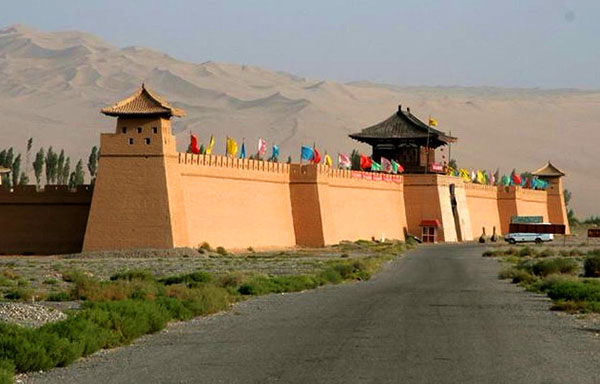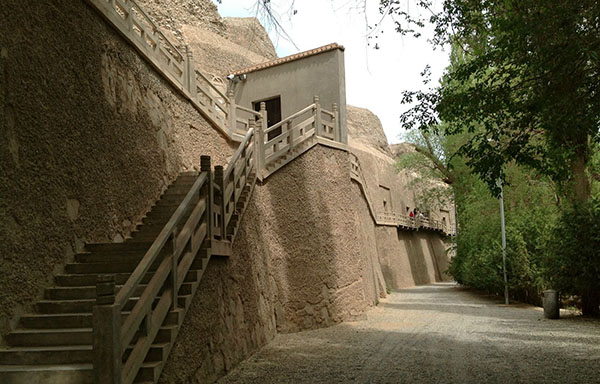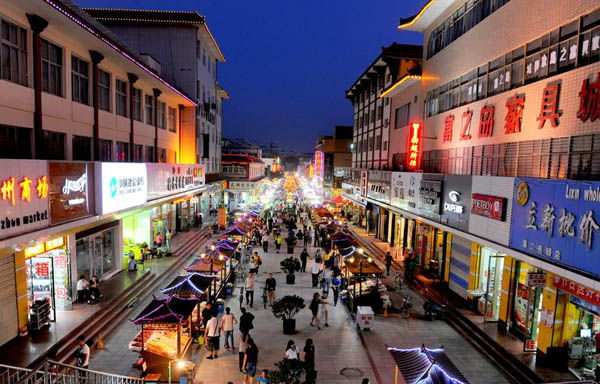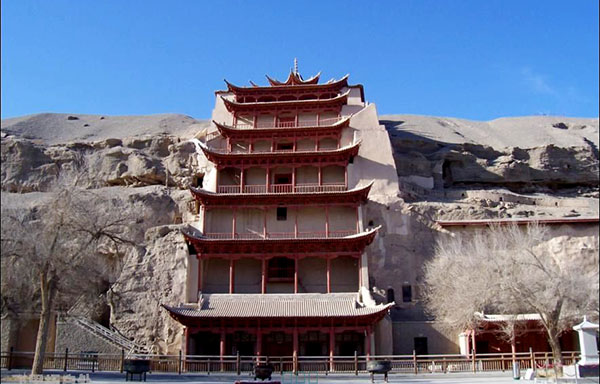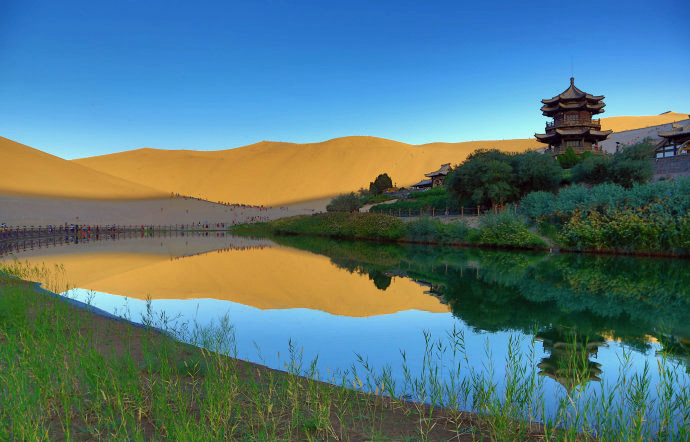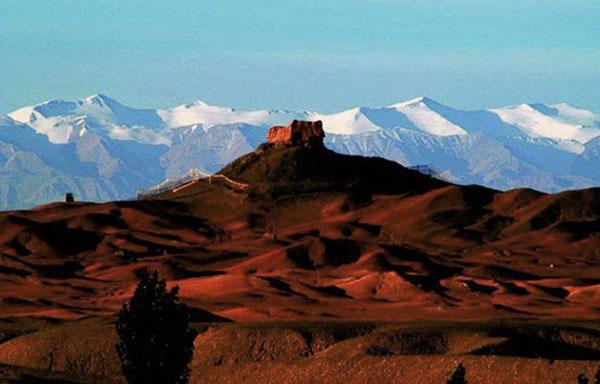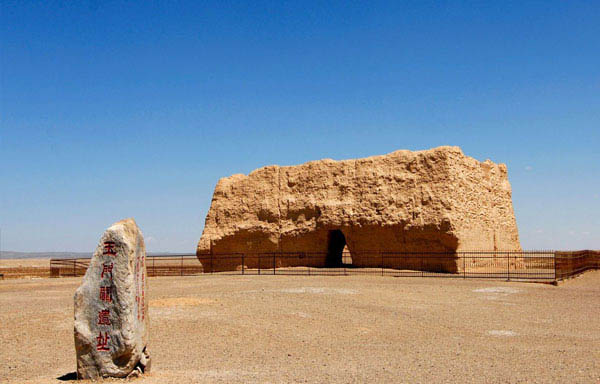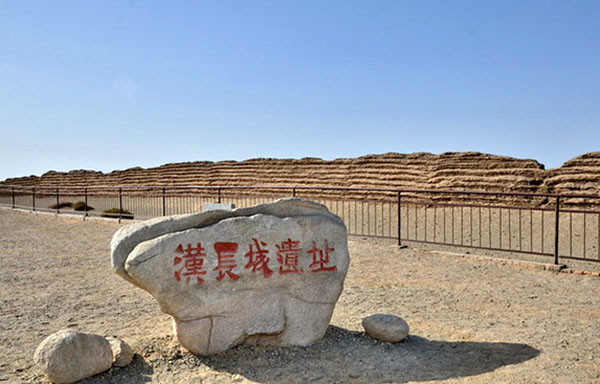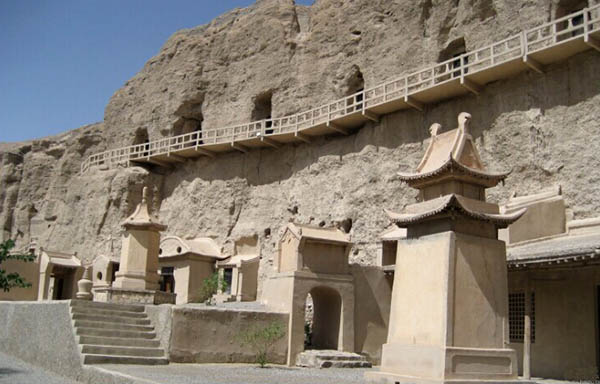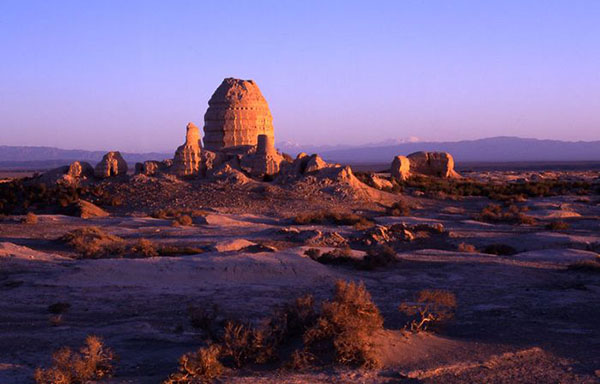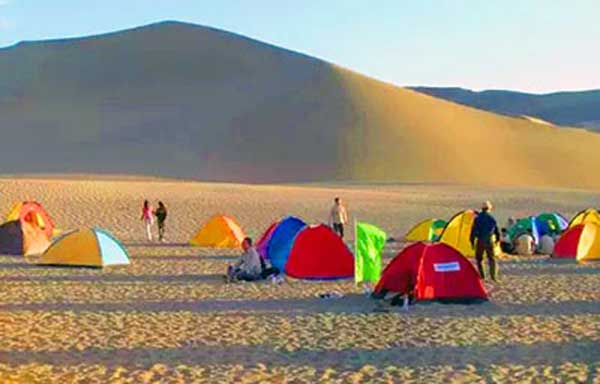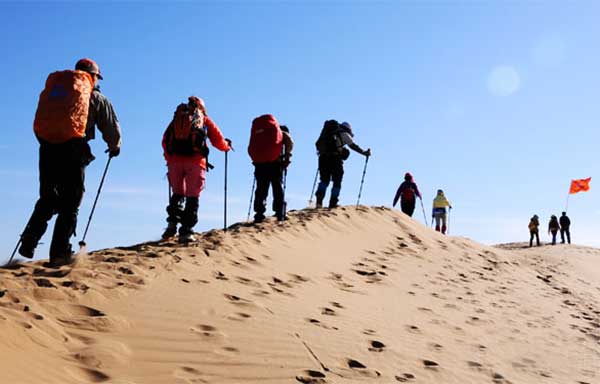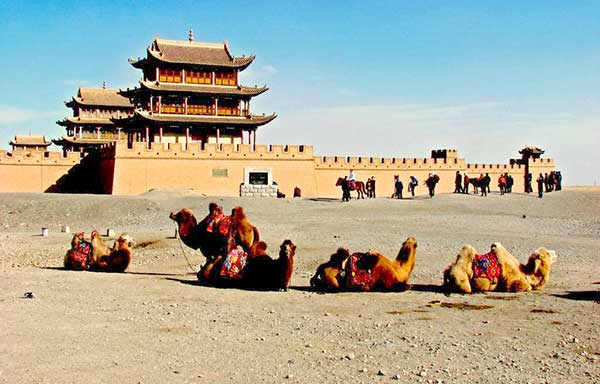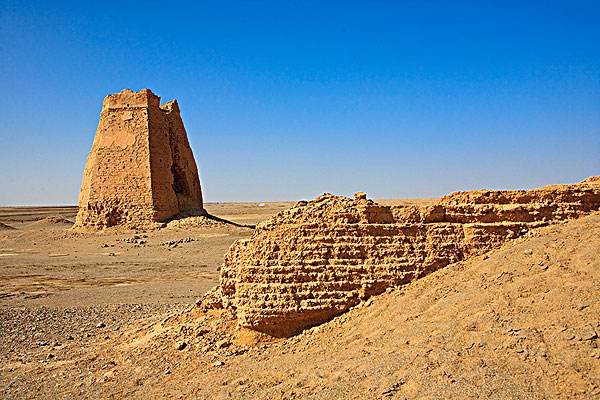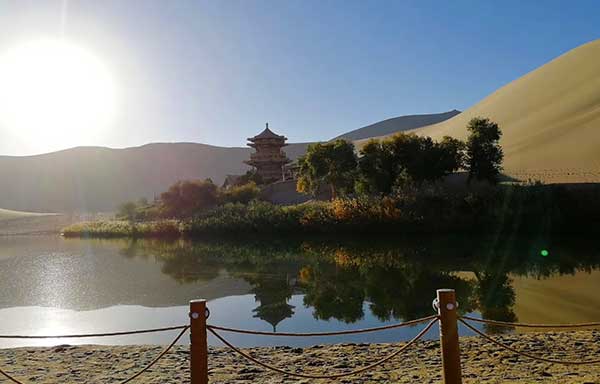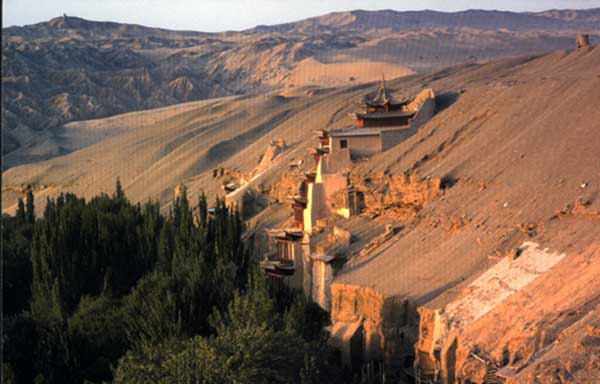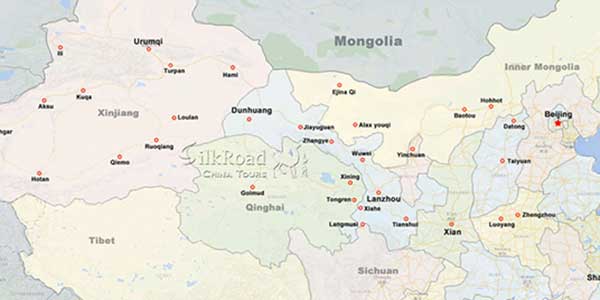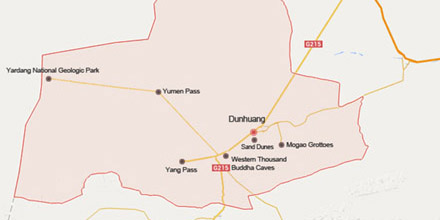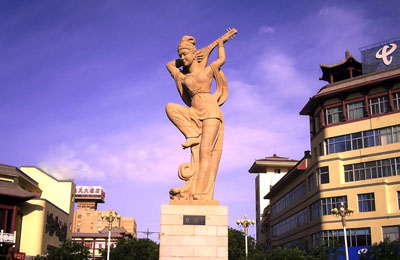 Dunhuang ( means large and properous in Chinese) is a city in northwestern Gansu province, Western China. It was a major stop on the ancient Silk Road, was known at times as Shāzhōu (沙州), or 'City of Sands', a name still used today.It commands a very strategic position at the crossroads of the ancient Southern Silk Route and the main road leading from India via Lhasa to Mongolia and Southern Siberia,as well as controlling the entrance to the narrow Gansu Corridor which led straight to the heart of the north Chinese plains and the ancient capitals of Chang'an (today known as Xi'an) and Luoyang. There is evidence of human habitation in the Dunhuang area as early as 3,000-4000 years ago, possibly by people recorded as the Qiang in Chinese history. Its name was also mentioned as part of the homeland of the Yuezhi or "Rouzhi" (月氏) in the Shiji (史記), however, if is possible that this mention may refer to an unrelated toponym, Dunhong. By the third century BC, the area became dominated by the Xiongnu( or huns), but came under Chinese rule during the Han Dynasty after Emperor Wu defeated the Xiongnu in 121 BC. Dunhuang was one the frontier garrison towns established by the Emperor Wu after the defeat of Xiongnu, and the Chinese built fortifications at Dunhuang and sent settlers there. The name Dunhuang, or Blazing Beacon, refers to the beacons lit to warn of attacks by marauding nomadic tribes. Dunhuang Commandery was probably established in 104 BC, or shortly thereafter. Located in the western end of the Hexi Corridor near the historic junction of the Northern and Southern Silk Roads, Dunhuang was a town of military importance.
Dunhuang ( means large and properous in Chinese) is a city in northwestern Gansu province, Western China. It was a major stop on the ancient Silk Road, was known at times as Shāzhōu (沙州), or 'City of Sands', a name still used today.It commands a very strategic position at the crossroads of the ancient Southern Silk Route and the main road leading from India via Lhasa to Mongolia and Southern Siberia,as well as controlling the entrance to the narrow Gansu Corridor which led straight to the heart of the north Chinese plains and the ancient capitals of Chang'an (today known as Xi'an) and Luoyang. There is evidence of human habitation in the Dunhuang area as early as 3,000-4000 years ago, possibly by people recorded as the Qiang in Chinese history. Its name was also mentioned as part of the homeland of the Yuezhi or "Rouzhi" (月氏) in the Shiji (史記), however, if is possible that this mention may refer to an unrelated toponym, Dunhong. By the third century BC, the area became dominated by the Xiongnu( or huns), but came under Chinese rule during the Han Dynasty after Emperor Wu defeated the Xiongnu in 121 BC. Dunhuang was one the frontier garrison towns established by the Emperor Wu after the defeat of Xiongnu, and the Chinese built fortifications at Dunhuang and sent settlers there. The name Dunhuang, or Blazing Beacon, refers to the beacons lit to warn of attacks by marauding nomadic tribes. Dunhuang Commandery was probably established in 104 BC, or shortly thereafter. Located in the western end of the Hexi Corridor near the historic junction of the Northern and Southern Silk Roads, Dunhuang was a town of military importance.
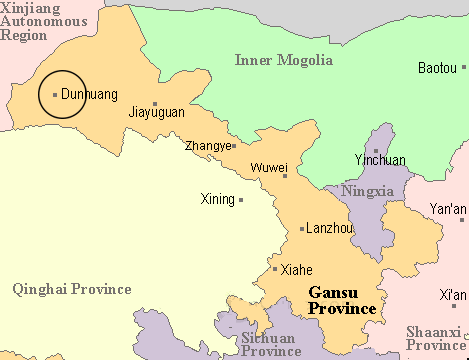 The Great Wall was extended to Dunhuang, and a line of fortified beacon towers stretched westwards into the desert. By the second century AD Dunhuang had a population of more than 76,000 and was a key supply base for caravans that passed through the city: those setting out for the arduous trek across the desert loaded up with water and food supplies, and others arriving from the west gratefully looked upon the mirage-like sight of Dunhuang's walls, which signified safety and comfort. Dunhuang prospered on the heavy flow of traffic. The first Buddhist caves in the Dunhuang area were hewn in 366AD.During the Sui and Tang dynasties, it was a major point of communication between ancient China and Central Asia. By the Tang Dynasty it became the major hub of commerce of the Silk Road. Early Buddhist monks arrived at Dunhuang via the ancient Northern Silk Road, the northernmost route of about 2,600 kilometres (1,600 mi) in length, which connected the ancient Chinese capital of Xi'an westward over the Wushao Ling Pass to Wuwei and on to Kashgar.[5] For centuries, Buddhist monks at Dunhuang collected scriptures from the West, and many pilgrims passed through the area, painting murals inside the Mogao Caves or "Caves of a Thousand Buddhas.A small number of Christian artifacts have also been found in the caves (see Jesus Sutras), testimony to the wide variety of people who made their way along the Silk Road.
The Great Wall was extended to Dunhuang, and a line of fortified beacon towers stretched westwards into the desert. By the second century AD Dunhuang had a population of more than 76,000 and was a key supply base for caravans that passed through the city: those setting out for the arduous trek across the desert loaded up with water and food supplies, and others arriving from the west gratefully looked upon the mirage-like sight of Dunhuang's walls, which signified safety and comfort. Dunhuang prospered on the heavy flow of traffic. The first Buddhist caves in the Dunhuang area were hewn in 366AD.During the Sui and Tang dynasties, it was a major point of communication between ancient China and Central Asia. By the Tang Dynasty it became the major hub of commerce of the Silk Road. Early Buddhist monks arrived at Dunhuang via the ancient Northern Silk Road, the northernmost route of about 2,600 kilometres (1,600 mi) in length, which connected the ancient Chinese capital of Xi'an westward over the Wushao Ling Pass to Wuwei and on to Kashgar.[5] For centuries, Buddhist monks at Dunhuang collected scriptures from the West, and many pilgrims passed through the area, painting murals inside the Mogao Caves or "Caves of a Thousand Buddhas.A small number of Christian artifacts have also been found in the caves (see Jesus Sutras), testimony to the wide variety of people who made their way along the Silk Road.
As a frontier town, Dunhuang was fought over and occupied at various times by non-Han Chinese nationalities. After the fall of Han Dynasty it was under the rule of various nomadic tribes such as the Xiongnu during Northern Liang and the Turkic Tuoba during Northern Wei. The Tibetans occupied Dunhuang when the Tang empire became weakened considerably after the An Lushan Rebellion; and even though it was later returned to Tang rule, it was under quasi-autonomous rule by the local general Zhang Yichao who expelled the Tibetans in 848. After the fall of Tang, Dunhaung was ruled by a local Cao family who formed alliances with the Uighurs and the Kingdom of Khotan. During the Song Dynasty, Dunhuang fell outside the Chinese borders. In 1037 it came under the rule of Shazhou Uighurs, then in 1068 the Tanguts who founded the Xi Xia Dyansty. It was conquered in 1227 by the Mongols who sacked and destroyed the town, and became part of China again when Kublai Khan conquered the rest of China. Dunhuang went into a steep decline after the Chinese trade with the outside world became dominated by Southern sea-routes, and the Silk Road was officially abandoned during the Ming Dynasty.
Today, the site is an important tourist attraction and the subject of an ongoing archaeological project. A large number of manuscripts and artifacts retrieved at Dunhuang have been digitized and made publicly available via the International Dunhuang Project. The expansion of the Kumtag Desert, which is resulting from long-standing overgrazing of surrounding lands, has reached the edges of the city.
Dunhuang was of great importance as a defensive and cultural center on the western borders of the Chinese empire at various points in its history. The routes west going north and south of the Taklamakan Desert split near Dunhuang. The route to the south and southwest was guarded by the so-called "Jade Gate" (Yü Guan) and "Southern Gate" (Yang Guan) which were garrisoned and supplied from Dunhuang. The Dunhuang region was the site of very important Buddhist monastic complexes, the most famous of which was at the Mogao Grottoes, where today one can see a treasure trove of Buddhist art covering a span of more than a millenium.
History
Dunhuang is a famous city in China as well as the world. It’s very hard to tell that how long history it has. But based on the potteries, stone wares and bronze wares excavated in the area, some scholars estimate that the nomadic lived along the rivers in Dunhuang as early as 4000 to 5000 years ago.
According to the historical record, the people lived here during early Qin dynasty (221BC-207BC) are the nomadic Wusong and Yuezhi. Yuezhi boasted of having 100,000 gritty fighters. They drove their neighbor- Wusong out of Dunhuang and Hexi corridor with force and controlled the vast grassland. But good times do not last long, in the early Han dynasty (203BC-176BC) another tribe intruded from Mongol Plateau, they were know as Huns or Xiongnu by Chinese. They defeated Yuezhi people, killed their king and drove the Yuezhe as far as Amu Darya in Mid Asia. The Huns controlled the corridor and became it’s dominator.
To the east of the Hexi corridor there laid the Chinese empire – Han. In order to defeat Huns and control the corridor, the emperor Wudi of the Han sent a diplomat Zhangqian to Mid Asia. His mission was to find the Yuezhi people and build alliance with them. It was the first time that Chinese people get to know the world west of Pamir’s. Zhangqian collected intelligence for the fight and made an important report to emperor Wudi. In 127BC and 121BC the emperor dispatched 2 important generals with soldiers and launched battle against Huns on the Mogol plateau and in the corridor. The Huns were finally defeated and dove to the west. The emperor Wudi established 4 prefectures along the corridor. They were Wuwei, Zhangye,Jiuquan and Dunhuang. Dunhuang was the last prefecture and the west most one. To the west of Dunhuang two passes were built to serve as the western gates and frontier defense post of Han Empire. The great wall was built along the corridor to screen the nomadic to the north from coming into China. The emperor Wudi encouraged Chinese businessmen to trade with countries to the west. Foreign traders were welcomed and well treated by Chinese government. The trade on the Silk Road came to a golden time.
After the great unification of Han dynasty, China again fell into destructive civil war (Wei and Jin Dynasty). Especially in the central China the old country was overthrown and replaced by several kingdoms. The kingdoms fought ceaselessly with each other. Numerous people were killed and forced to leave their home. Dunhuang, for its special location, avoided a lot of political disaster. A lot of people, among them there are commons as well as big clan and businessmen, migrated from central China to Dunhuang, Which not only boomed the local economy but its culture.
China was reunified in Sui dynasty (518-618). The stable central government and favorable policies made trade on the Silk Road recovered quickly. Dunhuang was valued by government for its important location and an international trade fair was held here in the Sui dynasty.
After the short Sui dynasty, Tang (618-907) built up the most powerful Empire of the world. The western Turks - the major barrier lay between east and west were defeated and cleared out. The trade on the Silk Road was entering the most glorious times. Benefited by the trade on the Silk Road, Dunhuang reached a climax of its development. It was not only a military center that most military operation to the west based on but a custom and trading center.
With the rise of Tibetans in mid Tang dynasty, the Tibetans gradually controlled the western region and tried to attack the Hexi corridor (727). Later the civil strife of Tang broke out in 755 and the central government maneuvered the soldiers stationed in Hexi and Dunhuang to central China for rescue. This gave the Tibetans good opportunity to conquer the corridor and Dunhuang. So Dunhuang was under the dominant of Tibetans for 67 years (781-848). The Chinese Han and other ethnic groups in Dunhuang had a miserable life and suffered great insult from Tibetans. In 848, a local squire named Zhangyichao, organized angry peasant and people to revolt against Tibetans. In the end, Tibetans were defeated and cleared out of Dunhuang. Zhangyichao led the army of victory westward and recovered the rest 10 prefectures occupied by Tibetans in 3 years. Zhangyichao brought with him the good news and maps of those recovered states to meet the emperor in Changan. The emperor was very glad and appointed Zhangyichao as the military governor of Dunhuang.
In the next 191 years, Dunhuang was under the government of Zhangyichao’s family and later Cao’s family. During the time the governors well developed the local economy and military power. They tried to get along with powers around Dunhuang.
With the collapse of Tang Empire, the declining Chinese economy can’t afford expensive exotic merchandise anymore. In the Song dynasty, the economic weight of China gradually moved to the south and the development of shipping technology finally resulted in the decline of trade of the Silk Road on land. Dunhuang gradually lost its former glory.
In 1036AD, the tangut people conquered Dunhuang and later Mongolians vanquished Western Xia and controlled Dunhuang.
In Ming dynasty of 1403AD, the government deserted Dunhuang and the land west of Jiayuguan pass. All the Chinese people were moved to the cities east of Jiayuguan pass. For over 300 hundred years, Dunhuang was looked as wasteland, only a few nomadic people still herded animals here.
In the Qing dynasty of 1715AD, the emperor Kangxi reclaimed Dunhuang and Xinjiang area. Thousands of Han family and army men were migrated to Dunhuang by the Qing government.
- 366AD, The monk Lezun and Faliang traveled to Dunhuang and built the first cave in Mogao.
- 400AD,The famous traveler and translator - monk Faxian passed by Dunhuang on his way to India.
- 530AD, The prefecture governor of Guazhou , Dongyangwang built up caves in Mogao
- 695AD, The monk Linyin and others built the giant Buddha in cave 96.
- 721AD, The monk Chuyan and others built the south giant Buddha in cave 130.
- 1877AD,The Eastern Asian expedition of Count Béla Széchenyi arrived at Dunhuang.
- 1900AD, The Taoist priest Wangyuanlu discovered library cave by chance.
- 1907AD, Aurel Stein came to Mogao caves and cheated away amount of scriptures and paintings.
- 1908AD, Paul Pelliot came to Mogao caves and cheated away amount of scriptures and paintings.
- 1910AD, officials escorted remains in the library cave to Beijing on request of Qing government.
- 1924AD, Landon•Warner took away 12 murals and 2 statues in Mogao.
- 1941AD, The famous painter – Zhangdaqian came to Mogao and have stayed 3 years for copy and study.
- 1944AD, The Dunhuang Research Academy was established.
- 1987AD, The Mogao caves was listed as the world cultural heritage by UNESCO.
In 1979, Dunhuang was opened up to the world and in 1986 Dunhuang was nominated as historically and culturally famous city of China.
Amusment
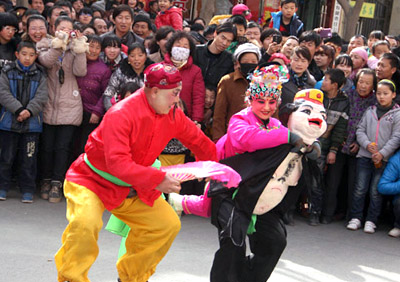 Dunhuang is rich in cultural and leisure activities. At spring season, there is a special mass makeup dancing performance named “Shehuo” which is organized by local citizens. During the performance, the whole street will be filled up with dancing groups of people in traditional clothes. With the loud drums and billowing flags, hundreds of people from the community get together to celebrate harvest and may the New Year auspicious.
Dunhuang is rich in cultural and leisure activities. At spring season, there is a special mass makeup dancing performance named “Shehuo” which is organized by local citizens. During the performance, the whole street will be filled up with dancing groups of people in traditional clothes. With the loud drums and billowing flags, hundreds of people from the community get together to celebrate harvest and may the New Year auspicious.
There are various kinds of “Shehuo” activities not only include Dunhuang local traditional performances, but also new quality programming from other cities. These local performances consist of Dragon Lantern, Stilt Walkers, Lion Dance, Land Boat, Running Donkey, and so on. Exotic performances include Shanbei Yangge Dance, Ansai Waist Drum, Weifeng Drums and Gongs, and Umbrella Dance. In recent years, another large-scale “Shehuo” event which is named "Dunhuang Dance" has been rehearsed in accordance with the drum and dance in Dunhuang frescoes. This kind of performance is filled up with traditional Dunhuang art style.
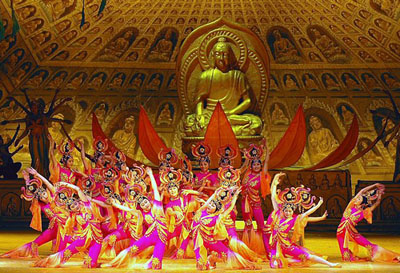 Dunhuang Goddess" is an acrobatic and music show based on a deer girl story taken from one of the cave murals, which was given by Gansu Provincial Acrobatic Troupe. The "Dunhuang Goddess" for the first time in the country wire stunt Magic Art into acrobatics, there are three major innovations: First, let "Flying" truly fly on stage together using acrobatic stunt so that "flying" above the stage shuttling back and forth, and the scene was thrilling, very spectacular. Suddenly bursting out from the chimney, and the audience the accident being surprised, and surprise being surprised, so beautiful "snow lotus with a magic trick. Camel "living props" boarded the stage, more the Reiki and realism of the stage, highly ornamental force. Performances of more than one hour, the story of ups and downs, exciting, touching, tear-jerking! Music sometimes vigorous, sometimes euphemistically deep sometimes cheerful agitation, sometimes full of pathos, very melodious and highly infectious. Performances and danger, climaxes, applause after another, the audience mesmerizing, soul-stirring, delightful, a feast for the eyes.
Dunhuang Goddess" is an acrobatic and music show based on a deer girl story taken from one of the cave murals, which was given by Gansu Provincial Acrobatic Troupe. The "Dunhuang Goddess" for the first time in the country wire stunt Magic Art into acrobatics, there are three major innovations: First, let "Flying" truly fly on stage together using acrobatic stunt so that "flying" above the stage shuttling back and forth, and the scene was thrilling, very spectacular. Suddenly bursting out from the chimney, and the audience the accident being surprised, and surprise being surprised, so beautiful "snow lotus with a magic trick. Camel "living props" boarded the stage, more the Reiki and realism of the stage, highly ornamental force. Performances of more than one hour, the story of ups and downs, exciting, touching, tear-jerking! Music sometimes vigorous, sometimes euphemistically deep sometimes cheerful agitation, sometimes full of pathos, very melodious and highly infectious. Performances and danger, climaxes, applause after another, the audience mesmerizing, soul-stirring, delightful, a feast for the eyes.
Average Monthly Temperatures
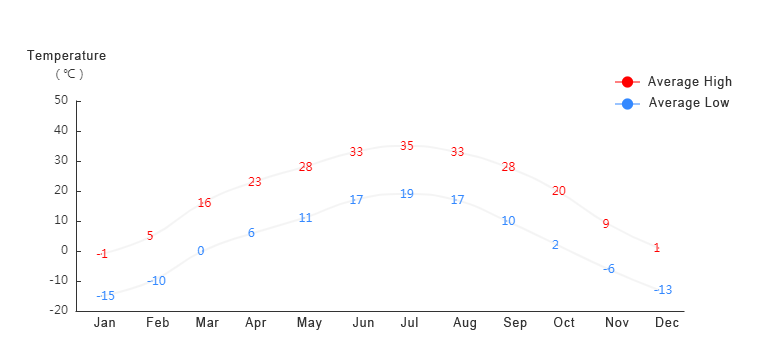
More information on Dunhuang tours, transportation, climate and entertainments. Click here
Attractions in Dunhuang
Related Tours
General Information
Alias: ShaChou
Area: 31,400 sq km
Location: Gansu
Airport: 13 km from city
Train Station: 10 km from city
Population: 200,000
Relevant blogs
-
What is the connection between "dragons" and "s
In traditional Chinese culture, the snake has a dual identity of auspiciousness and danger. Ancient people believed that the snake not only possesses divine cha
-
Endangered Przewalski's Horses Spotted at Dunhuan
<p>In early February, a group of special "visitors"—the Przewalski's horses—appeared at the Dunhuang Yumen Pass scenic area in Gansu Province, a U
-
The Fourth Dunhuang Cultural Tourism Supplier Conf
On the morning of February 18th, the Fourth Dunhuang Cultural Tourism Supplier Conference in Northwest China commenced at the Dunhuang International Convention
-
Hu-style Lamb Stew with Flatbread
The Historical Origins of Hu-style Lamb Stew with FlatbreadFor thousands of years, Dunhuang has been a crucial town on the ancient Silk Road. The people living
-
During the Spring Festival holiday, Dunhuang City
The city's major tourist attractions were bustling with visitors who came to explore the ancient city, admire the desert landscapes, experience the Silk Road c
-
Dunhuang fresh grapes were exported to Iraq for t
On January 6th, 42 tons of red table grapes, under the supervision of Dunhuang Airport Customs under Lanzhou Customs, set off from Shekou Port for Iraq. This is

